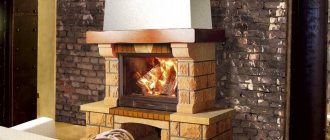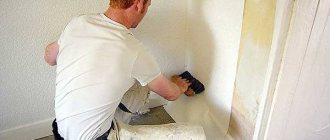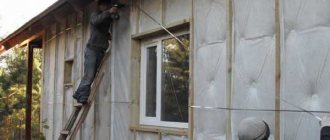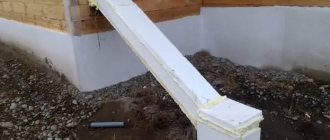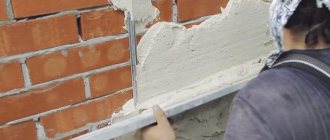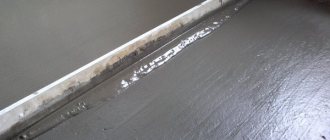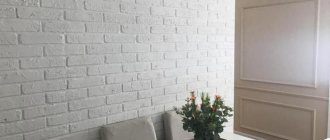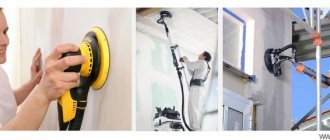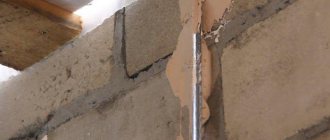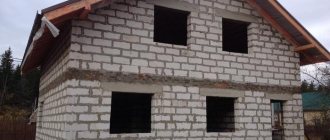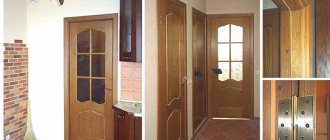Installing beacons for plastering walls seems to beginners to be perhaps the most difficult and incomprehensible task. And, although displaying beacons is a responsible task, however, it is not too difficult to master and do it yourself. A beginner needs to understand the intricacies of marking and creating an auxiliary plane, after which the rest of the work will no longer be so mysterious.
How to place beacons under plaster
A beginner, when starting to level walls, has little idea how to install the beacons, at what step to place them, or how to attach the guide profiles to the wall surface. The placement of beacons under plaster must be taken seriously, since only correctly aligned guides will allow achieving the required evenness of the walls. An incorrectly installed beacon (crooked or insufficiently fixed) becomes the cause of defects.
Let's talk about which beacon pitch to choose. The distance between the planks should be chosen based on the length of the rule with which you will level the plaster mixture. It is better for beginners to use a short tool (up to 1.5 m). This rule is simpler and easier to manage.
Since the rule is supported and moved along the beacons during alignment, the maximum pitch of the guides is set less than the length of the rule bar by 20 cm (up to 1.3 m). The minimum step can be any, most often it is 0.8 m. The distance of the outer guides from the internal corners is 10-30 cm. When installing beacons, they retreat from door or window openings by 0.1-0.15 m.
The main stages of placing beacons for wall alignment:
- mark the surface of the structure to be leveled;
- set guidelines for the outer beacons;
- at a short distance from the surface to be leveled, using levels, a plumb line or a laser level, create an auxiliary strictly vertical plane using laces (threads, rays of light);
- take measurements of the deviations of the wall surface from the auxiliary plane, find the “zero point” - the place where the surface protrudes most;
- the auxiliary plane is corrected, taking its elevation above the zero point by the thickness h of the plaster layer;
- install alternately two extreme beacon profiles according to the position of the adjusted auxiliary plane;
- install intermediate profiles, checking their position along the outer guides;
- prime the mortar part of the beacons (laps or mortar paths).
Is it necessary to remove or remove beacons after plastering?
It is definitely necessary, even though they are galvanized. During the plastering process, galvanization is scratched and with exposure to moisture, the beacon will rust and the oxide will lick out through the wallpaper or paint, in the form of brown rusty stripes or spots. If the profile does not rust and the sellers convince you of this, then I will disappoint you - they oxidize and the gray oxide spots will still show through.
We dismantle the beacons using a hammer or hatchet, or you can simply pick it up with a spatula and pull it out along its entire length.
Therefore, we take out the beacons, do not reuse them, remove them and throw them away. I don’t think we are all so poor that we will skimp on lighthouses. It is allowed to leave profiles in places where there will be ceramic tiles or finishing stone, such as bathrooms, kitchen surfaces, floors or decorative parts of walls. In other cases we get it. It is advisable to remove beacons everywhere, because rust is unpredictable.
How to place beacons under plaster walls without a laser level
The main thing here is to correctly align the beacon profiles under the plaster.
Like any installation technology, the installation of beacons for plastering walls includes marking the area with the subsequent alignment and fastening of profiles to the surface.
Before the advent of laser levels, plasterers used a plumb line and a ruler to mark, driving nails into the wall, the heads of which, aligned in the same vertical plane, served as a guide. In addition to the plumb line, a building level is used to check verticality.
To install beacons for plastering walls, two main marking methods are often used:
- regular markings;
- spider method.
Methods for marking beacons
Regular markup
Let's look at how to set beacons in the usual way. You will need a level and a nylon thread. Our task is to create a strictly vertical auxiliary plane, spaced from the “zero” point (see gallery below) at a minimum distance (h) - the thickness of the solution. For different plaster mortars, h is different (usually indicated on the packaging of the dry mixture as the minimum thickness).
Taking into account the fact that the beacon profiles already have their own height b (mm), formed by the heads of the screws, the auxiliary plane should rise above the zero point by (h – b) mm.
- We retreat from the corner of the room 10 cm, from the ceiling 15-20 cm (point A). Similarly, on the other side of the wall we mark point (B). At both points we install a self-tapping screw protruding 3-5 cm above the wall.
- We attach a plumb line to the first screw, and under the thread we mark two new points (A1 and A2): the first at a distance of 0.15-0.2 m from the floor, the second in the middle between A and A1. We screw in the screws. Similarly, mark points B1 and B2 and install two more screws.
- At this stage, you need to align all the caps in the same plane. To do this, we pass the cord of the plumb line tied to the upper screw over the head, and screw in or unscrew the underlying screws so that their heads touch the cord passing above them. We do the same with the screws on the other side.
- We stretch a horizontal line (lace) between the opposing screws, passing it over the caps. We connect the fishing line and the diagonals (A-B1 and A1-B). If the hardware is installed correctly, the diagonal lines will touch in the middle.
- We mark points C and D (10 cm to the center from A and B under the horizontal line). We also install on self-tapping screws with caps adjacent to the fishing line (for convenience, we draw lines between the screws with a marker). Having measured the distance CD, we divide it into segments of length from 100 to 150 cm (the distance between the beacons). We install the hardware, focusing on the fishing line.
- For all new screws, repeating the operations described above, we install a pair of lower beacons on the lines.
- The resulting vertical plane makes it possible to identify the most protruding point of the wall (zero), which is determined by measuring the distances from the wall to the plane formed by the fishing lines.
- If the distance between the zero point and the vertical plane is greater than h or hb, we adjust the position of the plane by screwing or unscrewing the hardware to the same distance.
Marking points A1 and A2
Installation of self-tapping screw
Pulling the lace
Marking points C and D
Determining the zero point
If clips are used to attach beacons, then the thickness of the clip plate is also taken into account.
Screwing and unscrewing screws simultaneously is not difficult. It is enough to tighten or unscrew them by the same number of turns, because the thread pitch of the self-tapping screws is the same.
Spider markup
Installation of beacon strips for plastering walls is carried out in another way - the “spider” method. The name arose due to the use of four (two horizontal, two vertical) stretched threads. However, if everything is done carefully, high accuracy is achieved. The method will help to determine the optimal thickness of the coating for leveling, which means that the consumption of plaster on the beacons will be minimal.
- Having retreated from the corners of the wall (and from the ceiling) 15 and (5) cm, mark points, drill a hole in them, then, inserting a dowel, screw in 2 self-tapping screws with a screwdriver so that the caps rise above the wall by 5 cm.
- Now you need to use a plumb line to mark a place above the wall, 5 cm from the floor, for installing two more screws (strictly vertically, under the top ones). Holes are drilled into which self-tapping screws are installed, protruding from the wall also by 5 cm.
- At a distance of 2 cm from the wall surface, a nylon thread is tied to the upper screws. Using a plumb line, notice on the lower screws the places where you need to tie the nylon thread coming from above, so that it is strictly vertical. In these places the ends of the threads are tied with tension.
- A pair of horizontal threads is tied to two threads stretched vertically so that they can be moved. By moving horizontal threads along the wall, they reveal the curvature of the surface, the maximum protrusion (zero point), as well as whether the wall is collapsing and in which direction.
- If the distance from the zero point to the horizontal thread is greater than the minimum possible layer thickness for the selected plaster (h for beacons made of mortar, or hb - in the case of using standard profiles, where b is the height of the flange of the beacon profile), screws are screwed deeper into the wall at the same distance, ensuring that the horizontal thread is positioned above the zero point by the amount h (or hb). If the zero point protrudes beyond the vertical plane formed by the threads, the protruding section is cut off, or all screws are unscrewed to the same distance.
- Along the created vertical zero plane, 3-5 self-tapping screws are placed under each thread, the heads of which touch the threads.
Installation of 2 screws
Marking the space for screws using a plumb line
Attaching a horizontal thread
Installing screws under the thread
Setting up intermediate beacon profiles along two precisely oriented lines is no longer difficult. You can place beacons in the gap under horizontally stretched threads. Any beginner can handle this.
Installing beacons using a laser level
This installation option is a little easier and faster, in my opinion:
- We mark diagonal lines at the locations of future beacons to make it easier to apply mortar or glue.
- Then we set the laser level, but on a flat area of the floor, it is advisable to place cardboard or a piece of drywall. Along the ceiling and floor, we make sure that the laser line runs parallel to our wall (approximately at a distance of 5-10 cm from the wall).
- Using a tape measure or ruler, we find the smallest distance from the wall to the laser (for example, this is 5.5 cm for us)
- Then we take a small square (corner). Use a pencil to mark 5.5 cm on it.
- We apply plaster solution or glue to the vertical lines (which we prepared at the beginning).
- We apply it so that it just holds on and doesn’t fall.
- Then we take a square (if you don’t have one, you can just use a tape measure) and press on the profile until the laser line touches the mark (our example is 5.5 cm)
- When the lighthouse is pressed down evenly over the entire plane and everywhere 5.5 cm from the laser, then you can apply a level or rule and look for holes or bumps on the lighthouse itself, you need it to stand straight as a string.
How long does it take for lighthouses to dry? I recommend plastering the next day. But if you exposed it to gypsum mixture or glue (and will plaster with plaster), then you can start working in 2-4 hours.
We set subsequent beacons in the same way. We wash them well and check them at the end with a level and a rule. We are waiting for it to dry completely, most likely this will happen the next day. We take the rule and run it along the beacon profiles, making sure that nothing touches or protrudes beyond the edges of the rule. If something touches, it is knocked off with a hammer or removed with a spatula. If you were wondering “can beacons be reused?”, then my answer is definitely “no!” After the first use, they become curved like a saber; they are often already sold crooked, what can we say about secondary use.
One more nuance, it is not advisable to place beacons on gypsum mortar, but to plaster them with cement. Gypsum and cement plasters do not make good contact.
How to place beacons under plaster walls using a laser level
One of the modern marking tools used is a laser level. Using it, placing beacons under plaster walls is much faster and easier. You can also use a laser level to set a right angle between adjacent walls. You will need a rule 5-10 cm long less than the height of the wall. The device is placed perpendicular to the wall near the corner (if the wall is short) or in the middle (if the surface to be plastered is long).
We install the laser level as close to the wall as possible (3-4 cm) so that the plane created by its beam is parallel to the one being processed and perpendicular to the adjacent, already plastered wall. We mark with a pencil the places where the lines of light pass, so that when knocking down we can place the device in the same place. Using a metal square, we measure the deviation of the wall surface from the plane formed by the beam, recording the results on the surface or in a notebook.
- Having identified the zero point, we mark it with a cross, measure or calculate the distance from the light plane to the future surface. Let’s say that from the zero point to the beam is 25 mm, the plaster layer is 10 mm, the height of the beacon profile is 6 mm. We calculate the minimum distance between the beam plane and the top of the beacon ribs: 25 – 10 = 15 mm (see figure).
- To mark the rule in three places, glue masking tape onto its plane, onto which we apply a mark spaced 15 mm from the working edge (or draw a line directly on the rule, spaced 15 mm from the edge). The beam must pass along this mark when setting the rule on the edge of the beacon being set.
- We draw beacon installation lines on the walls. We throw along the line furthest from the level the solution. We install the profile bar by slightly pressing it into the solution.
- We set the rule with the edge on the edge of the profile and press the profile against the wall with the tool so that the laser beam coincides with the marks on the tape.
- We set aside the rule, remove excess solution, clean the top of the beacon with a spatula so that the working surface is clean and smooth.
- We install the following profiles in a similar way, sequentially approaching the level.
Zero line
Attaching grafted to the lighthouse
Combining the line on the rule and the laser beam
Removing excess solution
Installing a beacon on a solution
Marking beacons is done with a laser level several times faster than other types of marking.
Advantages of lighthouse plaster
To ensure a flat and smooth surface, two types of plaster can be used:
- monolithic (wet);
- dry.
In the latter case, the ceiling or walls are sheathed with sheets of plasterboard. This finish is several times cheaper than wet plaster, but has a number of disadvantages. Its disadvantages:
- short service life;
- is not able to withstand tiling materials.
Monolithic plaster is carried out by applying a working solution to walls, partitions and ceilings. Wet method:
- provides reliable adhesion to various substrates;
- forms a moisture-resistant coating, making it suitable for the bathroom, winter garden, and basement.
Applying wet plaster is a labor-intensive process. But if you know the procedure for performing the work and the technology for applying the mixture, you will be able to create a high-quality base for finishing. Plastering beacons with your own hands will allow you to achieve a smooth surface, devoid of convex elements and roughness.
Types of plaster beacons
Beacons made of different materials are used as guides when leveling walls.
It can be:
- mortar (tracks made from mortar, the top edge of which serves as a guide);
- metal profiles (made of aluminum or galvanized steel);
- plastic profiles (disadvantage - they bend easily);
- wooden slats (rarely used, secured in place with nails);
- strings.
Types of lighthouses
All types of beacons have advantages and disadvantages. It is not recommended to leave beacons made of metal in the plaster; they are removed after the composition has set. Profiles left behind will corrode over time, causing rust spots to appear. Wooden slats can swell and warp from moisture. Plastic profiles warp too easily, making them more difficult to install and secure accurately.
In addition to T-shaped beacon profiles, L-shaped ones are produced. They are installed on plastered protruding corners. After leveling, the L-shaped profiles are left in the thickness of the finish.
Metal beacons come in lengths of 3 or 6 m. They are cut to size before installation.
Selecting beacons
Today, beacons for plastering walls are produced in different ways; they can be bought on the construction market, or made from mortars. The variety of possible options allows even beginners to carry out the work. But how to properly plaster the surface on beacons will also depend on the choice of their type.
Beacons for walls differ in size, release form, and also in material of manufacture. This is how these products are presented on the market with a thickness of 3 mm, 6 mm. and 10 mm. The degree of rigidity of the beacon is important here. If the manufacturers chose a thin sheet for the manufacture of the product, then during installation the master will have to face the fact that they bend under the influence of the rule, and alignment will be much more difficult.
Most often, the choice falls on metal beacons on the wall for plaster; in this case, the evenness and quality of the work is also affected by the transportation of the product. If the beacons were carelessly bent during transportation, then further work with them will be difficult or almost impossible.
This problem does not arise with wood products. They show good flexibility. They also come in three types of thickness. But working with them is less convenient and somewhat more difficult; they are usually chosen for repairs in small spaces.
Plastic beacons are made from durable plastic and come at a higher price. They are also convenient to use. Unlike metal ones, they cannot leave traces of rust on the surface, which happens with metal profiles; to avoid this problem, you can choose aluminum profiles.
Most often, the choice falls on metal beacons on the wall for plaster; in this case, the evenness and quality of the work is also affected by the transportation of the product.
Preparing the wall surface
Before placing beacons for plaster, the surface to be leveled is prepared. Get rid of unusable old coating, stains, mold, and excess metal parts. Cracks and chips are repaired. Smooth concrete surfaces are covered with notches, and the joints in the masonry are embroidered to a depth of 10 mm.
Details about plastering walls made of different materials:
- Plastering brick walls.
- Concrete walls.
- Plasters for wood.
Remove dust from the surface, dry it, the base must be primed and, after drying, reinforced (if necessary).
Factors influencing the correct installation of beacons
Installation of beacon strips is a critical stage of plastering work. It is important to avoid mistakes here, otherwise the entire result will be spoiled and everything will have to be redone. In particular, it is worth highlighting a number of fundamental factors that, one way or another, influence the final result:
- When choosing slats, you should pay attention to their condition. If there are defects or bending, the beacons cannot be leveled.
- If there is a slight difference in the walls, you can do without guide strips altogether. In this case, local alignment of the recesses is sufficient.
- It is worth choosing a suitable profile height, otherwise the plaster consumption will be exceeded. That is, rely on the value of the difference. With an indicator of 5 mm, the use of a 10 mm bar is unjustified.
- Foundation preparation also plays a role. And if pieces of old plaster remain on the wall, it will not be possible to fix the slats evenly.
Fact!
Any property owner tries to reduce the cost of work and the purchase of necessary materials and equipment. The condition of the surface also directly affects how the profiles will be installed.
Installation of beacons for plastering walls in different ways
When installing, the main thing is to securely fix the beacon profiles to the wall. To reliably, quickly and accurately install the beacon on the wall, use ready-made or home-made fasteners, for example, eared ears, clips. Often the installation of beacons for plastering walls is done using mortar.
To prevent the solution on which the profiles were installed from serving as an accelerator for the crystallization of the plaster composition applied during plastering, the flashings are coated with a primer after installing the beacons.
Installation on plaster mortar or tile adhesive
Let's look at how beacons are placed, when they are installed and fixed using a plaster mixture. If you install the profile directly on the screw caps, it may rotate during the fixation process, deviating from the correct position. Therefore, piles of plaster composition protruding above the caps are laid around the hardware with a spatula.
Round or rectangular “bedside tables” are formed from the slides; the top is cut off along an auxiliary vertical plane at the height of the caps. On such hardened bedside tables, it is much easier to place beacons under the plaster and secure them with plaster mixture or tile adhesive.
After installing the plaster beacons on the marks, fix the position of the profiles between them. Pieces of cut drywall can be useful here, from which you can make a mark of the required height by gluing the pieces with a solution or adhesive mass. If the beacon profiles are located close to the surface of the base, it is enough to place a mortar mixture under them in the right places.
Installation of beacons without mortar
Since our task is the reliable installation of beacons with protection against displacement during the plastering process, we need quick, strong fastening of the profiles to the self-tapping screws. For this purpose, several types of fasteners have been invented.
You can install beacons on hardware using:
- clips;
- creamers;
- eared;
- cleverness;
- homemade brackets made from straightened and cut beacon profiles.
The advantage of such fastening is the speed of installation, the absence of the need to wait for the plaster mixture to harden. In other words, it is enough to install the beacon profile and secure it with the fixing parts on the screws, and almost immediately after installation you can begin plastering. Beacon profiles installed on the walls will no longer move.
The disadvantage of such fastening compared to fastening to a plaster mixture is that it requires the installation of additional hardware, as well as the purchase of clamps.
Lighthouses from solution
You can make your own beacons for leveling walls using a plaster composition, for example, gypsum or cement. Such paths, made from the same plaster composition that will be used for subsequent plastering, do not need to be removed.
The easiest and fastest method is suggested by Andrey Shaiter.
To make guides from mortar, only a rule, a spatula and a trowel are used. The axes of the beacons are first marked on the wall, the zero point is found using a laser device, an auxiliary plane is set, and marks are made on the rule. Before starting work, prepare a viscous elastic solution.
Step-by-step production of a mortar beacon using the Scheiter method:
- the rule is installed on the edge (fixed in this position on the scaffolding);
- use a trowel to apply a solution to the upper edge of the rule;
- apply the correct bar with the solution to the wall, pressing until the line on the rule and the laser beam are aligned;
- using a rectangular trowel, adjust the angle of contact between the rule strip and the wall (to achieve the formation of a perpendicular);
- use a spatula to remove excess mortar from both sides of the instrument;
- using cotton threads, cut off the edge of the rule from the created mortar path, remove the rule;
- Allow the solution to dry for a day, after which they lightly pass along the top of the beacon with a block of sandpaper.
Fixation rule on scaffolding
Application of the solution
Adjusting the contact angle
Combining the line on the rule and the laser beam
Cutting off the rule from the track
This method creates mortar paths 2 cm wide. Made from gypsum, they dry out within a day and become suitable for plastering. During manufacturing, it is recommended to rest the lower end (heel) of the tool’s strip on a wooden wedge to avoid displacement of the strip when cutting with a thread.
Another method of making mortar guides and controlling their vertical level is somewhat more complicated.
- The rule bar is attached to the pre-installed screws to the wall (perpendicularly, on the edge).
- The gap between the plank and the wall is filled with mortar (without gaps).
- Use a spatula to remove excess plaster longitudinally from both sides.
- Gently tapping, shift the rule along the axis of the beacon, and then remove it from the formed path.
Types of lighthouses - what types of lighthouses there are
In this article we are looking at beacons for plastering walls, so there is only one main type of them, this is a metal galvanized beacon profile. There is also a homemade plaster beacon, which is made directly on the wall from plaster mortar, we will talk about it a little later. Another beacon on the outer corners of the walls can replace a metal perforated corner (you can immediately use a painting one) which is installed in any case, before or after leveling.
We will not consider any more species and fill our heads with them. There are many masters and craftsmen, everyone does as he wants and with what he wants. But I recommend not reinventing the wheel and plastering using standard galvanized plaster beacons. This is the answer to the question “which beacons are better?”
Materials and tools
To plaster with leveling compounds and prime, use conventional plastering tools.
To install beacons you will need:
- plumb line (laser level or building level);
- nylon lace;
- a set of dowels and screws (the length of the latter depends on the thickness of the leveling layer);
- spatula and trowel;
- marker or pencil for marking;
- trapezoidal rule (10 cm shorter than the height of the leveled wall);
- solution container;
- screwdriver (for self-tapping screws);
- metal scissors (needed to cut the profile into pieces for making fasteners);
- perforator;
- chisel and pliers for removing metal guides;
- masking tape.
Installing beacons for plastering walls may require purchasing beacon profiles and a sufficient number of screws (of different lengths). In the case of making mortar paths or attaching guides to the mortar, you will need to stock up on dry plaster mixture or components for preparing the composition.
What are beacons needed for?
A plaster beacon is a thin-walled metal perforated T-shaped profile. Its height is usually 6 or 10 mm. The 6 mm profile allows you to form a thin layer of plaster, which is suitable for smooth walls. However, in most cases, vertical planes have a curvature, and a noticeable one, and therefore the 10 mm bar is used more frequently.
The installation of plaster beacons plays an important role, as it ensures ideal verticality for the future coating. These elements act as a kind of reference level and at the same time serve as guides for the rule during leveling of the solution.
The plaster beacon is a metal T-shaped profile with perforation
Rules for plastering lighthouses
Leveling the walls by plastering is carried out following the rules developed over centuries.
- The plaster should not be stronger than the base material. During hardening and strength gain, internal stresses arise in the composition, which can be destructive for a weak base.
- The base surface must be carefully prepared before plastering. Any negligence will lead to the appearance of cracks, peeling of the plaster layer or the appearance of stains, efflorescence and other defects in the plaster.
- Applying a primer to patches, mortar marks, and mortar paths is mandatory.
- It is better to place beacons under the plaster slowly, especially paying attention to the accuracy of the geometric constructions.
- When plastering, the solution is applied evenly, spreading without leaving gaps.
- The strip between the guides is plastered in small sections, since otherwise too much excess mortar will accumulate on the rule. This may cause the instrument to become deformed.
- It is necessary to rest the rule on the guides only with slight pressure, so as not to damage the tops of the profiles.
- After leveling the mixture from bottom to top, one leveling is performed in the opposite direction, which ensures the mixture is fixed to the wall and prevents the composition from sliding.
- The profiles are removed until the plaster gains strength.
- The resulting grooves are filled with a solution that is more viscous than when plastering.
- If plastering is done with gypsum, then the excess is either immediately thrown onto the wall where the mixture is missing, or thrown into a separate container. The gypsum composition, which has already been on the wall, can cause the freshly prepared solution to instantly set, becoming the center of crystallization.
From all of the above, it is clear that the correct installation of the outer guides becomes the basis for the correct exhibition of intermediate beacons for plastering walls with your own hands. Having successfully completed the beginning of marking work, beginners usually get a taste for it and work with great pleasure, because the result - perfectly maintained geometry - is inspiring.
Lighthouse made of plaster (homemade)
There is no need to reinvent the wheel, but it is easier and ultimately faster to set up conventional beacons. But I know that many of us are not looking for easy ways and, in order to save material, are ready to spend more time on work. It very rarely happens that homemade beacons are the only correct way out of the situation. Fortunately, such situations do not arise often. And if you are a supporter of old-fashioned methods and think that this is how it should be done, then the flag is in your hands.
The principle is the same as with metal profiles, only the plaster beacon takes longer to make and the error in it is greater. The only plus is that it makes it possible to make a minimal layer of solution, because... a profile of a certain thickness is not used, and plastering begins from the zero level of the plane. The plaster or adhesive mortar is applied exactly diagonally to the wall and the excess mortar is removed using a rule or level until an even layer is obtained. Often such beacons are made from gypsum mortar, which is why they are called gypsum beacons.
After drying, the rule will still move in a dotted line, and will create additional problems during alignment. There are a couple more ways to make plaster beacons more accurately and level, but I believe that this all requires a certain skill and additional time. There are also methods with wire and wooden beams, but I won’t even consider that, because... this is a relic of the past.
Pull the “laces”
Using a hammer drill, we drill 6 holes with a drill (an impact drill for a hammer drill is called a drill) with a diameter of 6 mm along the edges of the profiles (to the right of the right and to the left of the left). The holes should be at the same distance from each other vertically as much as possible, that is, the lace lines should run as horizontally as possible.
To do this, measure along the edges of the beacons (between the corner and the beacon) an equal distance of 15-20 cm from the floor and ceiling along both edges and also find the vertical center of the wall and put marks. We drill holes for the dowels with self-tapping screws, insert the dowels, but do not screw in the screws.
We drill holes for screws on the right and left of the installed beacons
Having drilled the holes, we tie the end of the “lace” to the self-tapping screw near the cap. We tie it well so that it doesn’t come undone. We screw the self-tapping screw with the cord into the hole into which the dowel was previously inserted. The self-tapping screw with the cord must be recessed deeper than the lighthouse! If it is more convenient (if the depth from the beacon is shallow), then first screw in the self-tapping screw, then tie it with a string, then tighten the self-tapping screw.
I recommend: Question: How to make a screw pile for a fence?
We unwind the second end of the “lace” to the other edge. We screw the self-tapping screw into the second hole, not all the way. We tie the lace onto the self-tapping screw and screw the self-tapping screw deeper than the beacon. Thus, the lace lies tightly on the beacons, screwed with self-tapping screws. The tension should be strong enough so that it is like a string and does not sag. We expose two other “laces”.
The laces lie tight on the beacons
Tips and tricks
- It is necessary to carefully prepare the wall before applying plaster - if the same finish remains on the wall, then the necessary adhesion of the materials will not be achieved.
- If further finishing of the wall involves laying ceramic tiles, then the beacons do not need to be removed.
- When choosing a finishing material, it is worth considering the base material. So, simple cement-sand mixtures are not suitable for aerated concrete floors; for foam blocks it is better to choose a special composition.
- High quality grout is a prerequisite for obtaining a high quality wall finish. If you plan to tile the walls, then there is no need for grouting.
- Conventional reinforcement can be used as beacons; the main advantage of such elements is their strength. The reinforcement cannot be accidentally bent or memory.
- It can take up to 28 days or more for the plaster to dry - it all depends on the thickness of the plaster layer. No further work is carried out until the finish dries. If the waiting time is limited, it is worth adding gypsum or alabaster to the plaster mass - such an additive will speed up the drying of the finish. If it is important to avoid cracking, then slaked lime should be added to the composition.
If you plan to plaster walls using beacons yourself, you must first familiarize yourself with the technology of the process and, ideally, watch a photo or video master class. Only after this can you begin plastering work, having previously practiced on a small area.
